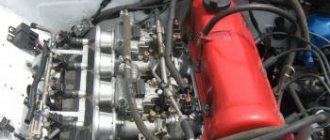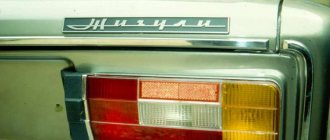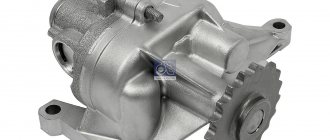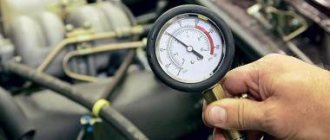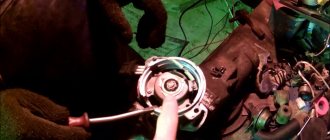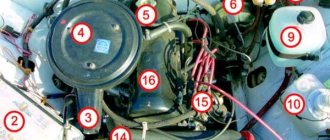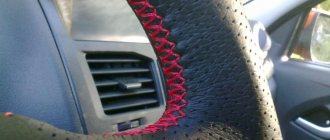Passenger cars are equipped with different types of engines; power units may differ in volume, power, and design.
Depending on the manufacturer, each engine has its own specific resource - the most basic serious failures are considered to be failure of the crankshaft or piston group.
If oil consumption in an engine increases, the most common reason for this is worn or broken piston rings; replacing them is quite labor-intensive work, and also requires certain plumbing skills.
Piston
Cast from aluminum alloy. To improve run-in, the outer surface of the piston (Fig. 5) is coated with a layer of tin. To compensate for uneven thermal expansion, the piston skirt has a complex shape. The piston has a conical shape: the upper part has a smaller diameter than the lower part. Therefore, it is necessary to measure the piston diameter only in a plane perpendicular to the piston pin and at a distance of 52.4 mm from the piston bottom.
The hole for the piston pin is shifted from the axis of symmetry by 2 mm to the right side of the engine. Therefore, in order to correctly install the piston into the cylinder, there is a “P” mark shown in the figure near the hole for the piston pin, which should be facing towards the front of the engine.
According to the outer diameter, the pistons are divided into five classes at 0.01 mm intervals, and according to the diameter of the piston pin hole - into three categories at 0.004 mm. The piston class (letter) and piston pin hole category (number) are indicated on the piston crown.
Spare parts include pistons of classes A, C, E. These classes are sufficient to select a piston for any cylinder, since pistons and cylinders are divided into classes with some overlapping sizes. For example, a class C piston may be suitable for class B and D cylinders. In addition, when repairing engines, pistons are usually replaced on worn cylinders, so a class C piston may be suitable for a slightly worn cylinder that was class B. The main thing when selecting a piston is to ensure the necessary installation gap between the piston and cylinder.
Since 1986, repair size pistons for all engine models have been manufactured with an outer diameter increased by 0.4 and 0.8 mm. Until 1986, pistons of the following repair sizes were produced: for engines 2101 - with an increase of 0.2; 0.4 and 0.6 mm; for 21011 - with an increase of 0.4 and 0.7 mm.
The pistons of engines 2101 and 21011 are easy to distinguish from each other by appearance. In addition to the fact that they have different diameters, the 2101 pistons have a smooth bottom, while the 21011 pistons have a cylindrical recess on the bottom with a diameter of 55 mm and a depth of 1.9 mm.
This is interesting: What is Valet
Replacing damaged parts without boring
Situations often occur when, due to knocking of connecting rods or stuck rings, people completely disassemble the engine and bore it, spending a lot of effort and money on this. However, if the cylinder has the correct round shape, has no scratches, burrs, cracks, and its actual wear does not exceed 0.15 mm, then boring and honing is not necessary.
In other cases, it is enough to simply replace worn parts. To do this, you don’t even need to remove the power unit from the car, just remove the cylinder head (cylinder head) and the oil sump. Typically, this method is used when replacing the piston rings of a VAZ 2106 is required. Work order:
- First, the battery is removed, the wires from the sensors and spark plugs are disconnected, the spark plugs are unscrewed and the distributor cover is removed.
- Then the antifreeze is drained, all coolant system hoses and all rods are unhooked from the cylinder head and carburetor.
- The air filter and fuel pump are removed.
- The cylinder head cover is removed and the marks on the camshaft pulley and bearing housing are aligned.
- The camshaft pulley bolt and the chain tensioner nut are loosened, the shoe is pressed out with a screwdriver and the bolt securing the camshaft pulley is unscrewed.
- The pulley is removed, and the upper part of the chain is attached with wire to the radiator.
- The nuts are unscrewed and the cylinder head bearing housing is removed.
- After this, the cylinder head bolts are unscrewed and the head is carefully removed to the side along with the gasket.
- The exhaust pipe (pants) is unscrewed from the gearbox and disconnected from the manifold.
- A strong board is placed on top across the engine compartment and the motor is attached to it.
- The engine cushions are unscrewed and it rises 3 cm.
- The engine oil is drained, the crankcase bolts are unscrewed and it is disconnected from the block.
- Unscrew 2 bolts from below and remove the oil pump.
- After this, the nuts of the connecting rod caps are unscrewed, the caps are removed and the pistons and connecting rods assembled are pushed upward with the handle of a hammer.
Assembly is carried out in reverse order. In this case, each piston should be inserted using a special mandrel. The “P” mark must face forward in the direction of travel. You can look up the sequence of tightening the cylinder head bolts and bearing housing nuts on the Internet. The pre-tightening torque of 10 cylinder head bolts is 3.4-4.2 kgf.m, the final tightening torque is 9.8-12 kgf.m. The 11th bolt is tightened to a torque of 3.5 kgf.m.
ENGINE VAZ 2106-1000260.
CHARACTERISTICS OF THE VAZ 2106 ENGINE.
The engine is four-stroke, carburetor, in-line, with an overhead camshaft. The engine cooling system is liquid, closed type, with forced circulation of liquid. The engine has a combined lubrication system: pressure and splash.
| Number of cylinders: | 4 |
| Cylinder displacement, l: | 1,57 |
| Compression ratio: | 8,5 |
| Rated engine power at a crankshaft speed of 5400 rpm: | 54.8 kW/74.5 hp |
| Cylinder diameter, mm: | 79 |
| Piston stroke, mm: | 80 |
| Number of valves: | 8 |
| Minimum crankshaft speed, rpm: | 850-900 |
| Maximum torque at 3400 rpm, N*m: | 104 |
| Cylinder operating order: | 1-3-4-2 |
| Octane number of gasoline: | 91-93 |
| Fuel supply system: | carburetor |
| Spark plug: | A17DVR, A17DV-10 |
| Weight, kg: | 121.0 |
Engine Features.
Engine 2106-1000260 is installed on VAZ 2103, 2106, 2121, 21053, 2107.
The VAZ 2106 engine is a modified VAZ -2103 engine
The change in engine power was achieved due to the engine displacement by increasing the cylinder diameter to 79mm.
Cylinder block 2106-1002011 with a cylinder diameter of 79 mm.
Five classes of cylinders are defined: A, B, C, D, E. (The difference in size between classes is 0.01 mm (the designation of its class is applied on the lower plane of the cylinder block, next to each cylinder)
Block head 21011-1005011-10.
New head gasket.
The 2106 engine has pistons from the 21011 engine with a diameter of 79mm.
The model 21011 piston differs from the 2101 piston by the presence of a cylindrical hole on the bottom of the piston and has an increased diameter. During operation, different zones of the piston heat up unevenly. To compensate for thermal deformation, the shape of the piston differs from the shape of a regular cylinder. Also in the piston bosses are steel temperature control plates. To reduce dynamic loads on the piston, the hole for the piston pin is offset to the right from the central axis by 2 mm. To ensure correct assembly, next to the hole for the piston pin, there is a marking in the form of a “P” symbol. During assembly, all pistons are oriented so that the marks are directed towards the front of the block.
Five classes are defined for piston diameters, with a difference in size of 0.01 mm. Classes are designated in Latin letters, similar to the designation of classes for block cylinders.
Pistons, based on the hole for the piston pin, are divided into three size categories - every 0.004 mm (categories are designated “1”, “2”, “3”). At the bottom of the piston, the piston class and piston pin size category are stamped.
Since 1986, two repair sizes for pistons have been determined: with an increase of 0.4 and with an increase of 0.8 mm.
Piston ring set 2106-1000100-10.
A special feature of this kit is that the oil scraper ring is chrome plated (unlike kit 2101). Chrome plating is performed to increase the service life of the ring, which was required to be carried out under increased load associated with an increase in engine power.
Set of steel rings – 2106-1004029.
Steel connecting rod, forged model 2101.
A 2103 crankshaft is installed on the engine (it differs from the 2101 crankshaft in the crank radius increased by 7 mm). On crankshaft 2103, on the main journal cheek, the marking “2103” is applied. Instead of shaft 2103, it is recommended to install crankshaft 21213 , which has the appropriate mounting dimensions.
Crankshaft 21213 has improved dynamic characteristics due to additional counterweights.
Carburetor “Ozone” 2107-1107010-20
Ignition distributor with vacuum ignition timing regulator. Ignition distributor 30.3706.01
Ignition coil B-117A.
Generator G221 42A.
Starter 35.3708 with a power of 1.3 kW.
The remaining components correspond to the elements of the VAZ-2103 engine.
Selection of spare parts
Before going to the store, you need to roll the car out to a bright place or use a flashlight for work. You need to open the engine compartment cover (hood), approach the car from the left front fender and carefully inspect the left vertical wall of the cylinder block. It is there, in the very center, that the capital Latin letter should be located, indicating the class of the motor.
If the letter is not visible, it means the engine is dirty. You need to clean the surface of the power unit from dirt using a sandblaster and look again. If after this the letter does not appear, it means that it was “eaten” by corrosion. In this case, before going to the auto store, you need to purchase a bore gauge and use this tool to measure the actual dimensions of each cylinder. It happens that some craftsmen do not bore all the cylinders during a major overhaul.
Class A engines that have not been overhauled or bored have cylinders with a diameter of 79 to 79.01 mm, class B - from 79.01 to 79.02, class C - from 79.02 to 79.03, class D - from 79 .03 to 79.04, class E - from 79.04 to 79.05 mm. The original pistons for these blocks have diameters of 78.93, 78.94, 78.95, 78.96 and 78.97 mm, respectively. These are approximate figures, since in reality there is a tolerance of 9 thousandths of a millimeter.
Table of dimensions and tolerances of VAZ classic engine parts
Spare parts stores supply cast pistons of classes A, C and D, intended for unbored engines. Forged pistons for the VAZ 2106 are made to order and come in any size. The main repair dimensions of the VAZ 2106 engine cylinders are 79.4 (first bore) and 79.8 mm (second bore). Piston diameters for the first boring depending on the class (in millimeters):
- A - 79.34.
- B - 79.35.
- C - 79.36.
- D - 79.37.
- E - 79.38.
Piston diameters for the second boring:
- A - 79.74.
- B - 79.75.
- C - 79.76.
- D - 79.77.
- E - 79.78.
It should be noted that pistons are also divided into 3 categories based on the diameter of the piston pin hole, so new pistons must be purchased complete with pins. It is very difficult for a non-professional to distinguish a bored block from an unbored one, so if you are doing major engine repairs yourself, you must definitely purchase a bore gauge, and if this is not possible, then at least take old parts with you and compare them with store-bought parts.
Specifications
| Manufacturer | Autoconcern "AvtoVAZ" |
| Start year of release | 1972 |
| Volume, cm³ | 1452 |
| Power, l. With | 71 |
| Torque, Nm | 104 |
| Compression ratio | 8.5 |
| Cylinder block | cast iron |
| Number of cylinders | 4 |
| cylinder head | aluminum |
| Fuel injection order | 1-3-4-2 |
| Cylinder diameter, mm | 76 |
| Piston stroke, mm | 80 |
| Number of valves per cylinder | 2 |
| Timing drive | chain |
| Turbocharging | No |
| Hydraulic compensators | No |
| Valve timing regulator | No |
| Lubrication system capacity, l | 3.75 |
| Oil used | 5W-30, 5W-40, 15W-40 |
| Oil consumption (calculated), l/1000 km | 0.7 |
| Fuel supply system | carburetor |
| Fuel | gasoline AI-93 |
| Environmental standards | Euro 2 |
| Resource, thousand km | 125 |
| Weight, kg | 120.7 |
| Location | longitudinal |
| Tuning (potential), l. With | 200* |
*without loss of resource 80 l. With
Engine piston rings
In an internal combustion engine (ICE), piston rings (PR) serve as a seal between the cylinder walls (liners) and the piston, due to which compression is created in the cylinders. If you forget to put the PC into the engine during assembly, the engine will not start, since the necessary compression of the working air-fuel mixture will not be ensured.
In passenger cars, three rings are standardly installed on each piston - two compression rings and one oil scraper ring, and oil scraper rings can be stacked, that is, consist of several elements. Compression piston rings (CPRs) are used to create compression in the cylinders and are always made of high-strength cast iron with various additives. The upper CPC has the greatest strength, since it operates in the most severe temperature conditions and experiences maximum loads.
Engine oil piston rings (OPRs) are needed to drain oil from the cylinder walls; if the rings do not perform their function, the engine will consume oil. MPKs can be either cast iron or steel, and cast iron PCs are almost always made in one piece, but steel oil scraper rings can only be assembled (composite). Steel MPC for one cylinder consists of:
- two spring steel rings;
- axial expander;
- radial expander.
Pistons and connecting rods.VAZ-— DRIVE2
Pressing out the piston pin.
Selection of piston to cylinder.
The calculated gap between the piston and cylinder (for new parts) is 0.025-0.045 mm. It is determined by measuring the parts and is ensured by installing pistons of the same class as the cylinders. The maximum permissible gap (if parts are worn) is 0.15 mm. If a used engine has a gap exceeding 0.15 mm, then it is necessary to reselect the pistons so that the gap is as close as possible to the calculated one. Spare parts include pistons of classes A, C, E. This is enough to select a piston for any cylinder during engine repair, since pistons and cylinders are divided into classes with a slight overlap of sizes. For example, a class C piston may be suitable for class B and D cylinders. A class C piston may also be suitable for worn class A and B cylinders.
Disassembly.
Remove the piston rings. Place the piston in the support with a cylindrical recess and press out the pin using mandrel A.60308 (Fig. 2-32). If some parts of the connecting rod and piston group are not damaged and have little wear, they can be used again. Therefore, when disassembling, mark them in order to later assemble a group with the same parts and install them in the same cylinder. Assembly. Before assembly, fit the pin to the piston. For proper pairing, it is necessary that the piston pin, lubricated with engine oil, enters the piston hole by simply pressing it by hand (Fig. 2-33) and does not fall out if the piston is held as shown in Fig. 2-34. Replace the finger that falls out with another one of the next category. If the third category pin falls out of the piston hole, replace the piston and repeat the selection of the pin.
Since the pin is inserted into the upper head of the connecting rod with interference, it is necessary to heat the connecting rod to expand its head. To do this, place the connecting rods for 15 minutes in an electric oven heated to 240°C. Prepare the finger for assembly in advance by placing it on the shaft of device A.60325 with spacer ring 5 installed. The ring should have a thickness of 4 mm, an outer diameter of 22 mm and an inner diameter of 15 mm. At the end of the device, a guide 3 is installed, secured with a screw 4. Tighten the screw loosely so that jamming does not occur when the pin expands from contact with the heated connecting rod. To properly connect the pin to the connecting rod, press in the pin as soon as possible, since the connecting rod cools quickly and after cooling it will be impossible to change the position of the pin. The piston and connecting rod must be assembled so that the arrow on the piston bottom is directed towards the oil outlet hole (if equipped) on the lower end of the connecting rod (see Fig. 2-31). Quickly clamp the connecting rod removed from the oven in a vice. When putting the piston on the connecting rod, make sure that the hole for the pin coincides with the hole in the upper head of the connecting rod. Push the piston pin attached to the device into the piston hole and the upper head of the connecting rod (Fig. 2-36) until the shoulder of the device stops in the piston. During this operation, the piston must be pressed by the boss against the upper head of the connecting rod in the direction of pressing the pin (shown by the arrow in Fig. 2-36). Then the finger will take the correct position. After the connecting rod has cooled, lubricate the pin with engine oil through the holes in the piston bosses. Lubricate the piston grooves, piston rings and
Thermal clearance of piston rings
PCs are spring discs with one cut - when installed on the piston, they expand, and in the sleeve they are pressed tightly against its walls. In order to achieve maximum compression of the working mixture, the cylinder walls must be as smooth as possible (without defects), and the shape of the internal cavity must be perfectly round. On the piston, the PCs are placed in special grooves, moreover, they are not seated tightly, and on a cold piston they move freely in the grooves.
Piston rings have thermal clearances:
- between PC and groove;
- at the junction.
The clearances must be certain; if they are larger or smaller than the required value, the piston group will quickly fail. One should take into account the fact that when heated, the metal expands, and if the thermal gap of the PC is too small, the piston group will begin to overheat. With large gaps, tightness is not ensured and power losses occur.
For passenger cars, as a rule, the following clearances are established:
- between the grooves and the PDA - from 0.02 to 0.08 mm (for the upper ring the gap should be slightly larger);
- between grooves and MPC – from 0.05 to 0.06 mm;
- at the junction - from 0.25 to 0.5 mm.
As wear occurs, the gaps in the PC increase, and they should not exceed:
This is interesting: Is it possible to drive a dead person’s car?
Replacing piston rings
On VAZ cars, as well as on all other models of passenger cars, it is advisable to change only the piston rings only if:
- there is no exhaust in the cylinders;
- there are no signs of damage to their inner surface.
If the liners are significantly worn, they need to be bored, and if the last size was already used before, the cylinder block needs to be relined. You can replace the PC on any VAZ engine without removing the internal combustion engine; this will require removing the cylinder head and oil sump. PCs are replaced if the gap at the joints does not exceed 1 mm.
For example, let's consider replacing piston rings on a VAZ-2114 car with an 8-valve internal combustion engine; such work must be carried out on a pit or a car lift:
- turn off the ignition, put the gearbox in neutral, disconnect the negative terminal from the battery;
- drain the antifreeze, remove the air filter housing along with the pipe (injector corrugation);
- remove the valve cover, camshaft, loosen the timing belt and move it to the side;
- disconnect the wires and cooling system pipes from the cylinder head, unscrew the head bolts;
- unscrew the nuts of the exhaust pipe of the muffler;
- We completely free the cylinder head from all fasteners that prevent it from being removed, and we remove the cylinder head;
- if there is protection under the engine, remove it;
- place a container under the engine sump, unscrew the plug on the crankcase, drain the oil;
- remove the lower hatch of the gearbox housing (three bolts);
- Using a 10 mm wrench or a socket wrench, unscrew all the oil pan bolts;
- dismantle the pan, remove the oil receiver;
- Unscrew the connecting rod nuts, remove the lower connecting rod caps, and carefully knock the pistons and connecting rods upward. Pistons should be knocked out through a soft metal drift or through a wooden block. First, you need to carefully knock out the connecting rod bolt without damaging the threads on it, then place the drift on the end of the connecting rod - in no case should you hit the bearings or the seat underneath them;
- It is recommended to remove the connecting rods one at a time, and immediately attach the caps to them; the caps should not be confused with each other, they are placed back strictly in their places, and a lock to the lock is required;
- remove the PC from the pistons, use a piece of the old ring to clean the piston grooves to bare metal. Be sure to check the cleanliness of the groove all around; there should be no coke left in it;
- We install new rings in the grooves, start with the lower MPC, then install the middle compression PK, and lastly the upper one. For installation, you can use a special device, but it is still more convenient to install the rings by hand. If the MPCs are cast iron, they cannot be bent along their axis, they can only be carefully moved apart. Compression rings also need to be bent carefully, to a minimum;
- we install the piston in place using a special mandrel, hammer it in with a wooden hammer handle or a brass or bronze drift;
- We install one piston-rod at a time, and immediately attach a connecting rod cap to each one. The connecting rod nuts should be tightened with a torque wrench, force - from 4.5 to 5.5 kg;
- then we put everything in place - the oil receiver, the engine sump, the cylinder head. We fill the radiator with antifreeze, oil into the crankcase, and start the engine to check. After replacing the PC, the internal combustion engine may initially smoke and consume oil - the engine needs to be run in for approximately 2 thousand km. It happens that despite the seemingly normal condition of the liners, the internal combustion engine continues to smoke even after replacing the rings after break-in. In this case, you will have to bore the cylinders and install a repair piston group.
Selection of piston for VAZ Zhiguli cylinder
- Repair manuals
- Repair manual for VAZ 2107 (Zhiguli) 1982+.
- Selection of piston to cylinder
The calculated gap between the piston and cylinder (for new parts) is 0.05–0.07 mm. It is determined by measuring the cylinders and pistons and is ensured by installing pistons of the same class as the cylinders . The maximum permissible gap (if parts are worn) is 0.15 mm.
| Rice. 3–25. Main dimensions of piston, connecting rod, piston pin and piston rings |
NOTE
The piston diameter is measured in a plane perpendicular to the piston pin, at a distance of 52.4 mm from the piston crown (see
).
According to the outer diameter, the pistons are divided into five classes (A, B, C, D, E) every 0.01 mm, and according to the diameter of the piston pin hole - into three categories every 0.004 mm.
The piston class (letter) and the piston pin hole category (number) are stamped on the piston bottom .
If a used engine has a gap exceeding 0.15 mm, then it is necessary to re-select the pistons to the cylinders so that the gap is as close as possible to the calculated one.
Spare parts include pistons of classes A, C, E. These classes are sufficient to select a piston for any cylinder, since pistons and cylinders are divided into classes with some overlapping sizes.
↓ Comments ↓
1. Vehicle operation and maintenance
1.0 Operation and maintenance of the vehicle 1.1. Vehicle operation 1.2 Vehicle maintenance
2. General information
2.0 General data 2.1 Technical characteristics of vehicles 2.2 Controls and monitoring devices 2.3. Ventilation control and interior heating
3. Engine
3.0 Engine 3.1 Removal and installation of the engine 3.2 Disassembling the engine 3.3 Possible engine malfunctions, their causes and methods of elimination 3.4 Engine assembly 3.5 Bench tests of the engine 3.6 Checking the engine on a car 3.7. Cylinder block 3.8. Pistons and connecting rods 3.9. Crankshaft and flywheel 3.10. Cylinder head and valve mechanism 3.11. Camshaft and its drive 3.12. Cooling system 3.13. Lubrication system 3.14. Supply system
4. Transmission
4.0 Transmission 4.1. Clutch 4.2. Gearbox 4.3. Cardan transmission 4.4. Rear axle
5. Chassis
5.0 Chassis 5.1. Front suspension 5.2. Rear suspension 5.3. Shock absorbers
6. Steering
6.0 Steering 6.1. Inspection, check and adjustment of steering 6.2. Steering mechanism 6.3. Steering rods and ball joints 6.4. Swing arm bracket
7. Brakes
7.0 Brakes 7.1. Checking and adjusting the brakes 7.2 Possible malfunctions of the brakes, their causes and methods of elimination 7.3 Bracket for the clutch and brake pedals 7.4. Vacuum booster 7.5. Brake master cylinder 7.6. Front brakes 7.7. Rear brakes 7.8. Rear brake pressure regulator 7.9. Parking brake
8. Electrical equipment
8.0 Electrical equipment 8.1 Electrical equipment diagram 8.2. Battery 8.3. Generator 8.4. Starter 8.5. Ignition system 8.6. Lighting and light signaling 8.7. Sound signals 8.8. Windshield cleaner 8.9 Headlight cleaner 8.10. Heater electric motor 8.12. Control devices
9. Body
9.0 Body 9.1. Doors 9.2 Possible body malfunctions, their causes and methods of elimination 9.3. Hood, trunk lid, bumpers 9.4. Body glazing 9.5. Windshield and headlight glass washers 9.6. Instrument panel 9.7. Seats 9.8. Heater and ventilation of the body interior 9.9. Body frame repair 9.10. Paint and varnish coatings 9.11. Anti-corrosion protection of the body
10. Modification and equipment of VAZ-2107 cars
10.0 Modification and equipment of VAZ-2107 vehicles 10.1. Car VAZ-21072 10.2 Car VAZ-21074 10.3. Car VAZ-21073-40
11. Applications
11.0 Appendices 11.1 Appendix 1. Tightening torques for threaded connections* 11.2 Appendix 2. Tools for repair and maintenance* 11.3 Appendix 3. Used fuels and lubricants and operating fluids 11.4 Appendix 4. Basic data for adjustment and control 11.5 Scheme
Dimensions of VAZ pistons cylinders
VAZ cylinder block dimensions: 2103, 2106, 21213, 21214, 2123, 2130.
Applicability - on engines: VAZ-2103, 21043, 21053, 21061, 2107.
What size piston rings for VAZ 2103:
How much does the VAZ 2106 engine block weigh? — Weight — 39,200 kg.
Applicability - on engines: VAZ 2106, 21067, 21074, 2121 Niva.
Applicability - on engines: VAZ 21213, 21073, 21214.
Applicability - on engines: VAZ 21214, 21073, 21213.
Applicability - on engines: VAZ 2123.
Applicability - on engines: VAZ 2130.
All of the above blocks are used on engines that belong to the line of “classical” design engines.
All these cylinder blocks share the same dimensions:
— the distance between the axes of adjacent cylinders, which is 95.00 mm;
— diameter of the bed for the crankshaft supports.
The table shows the main dimensions of VAZ cylinder blocks. (block repair dimensions)
| Cylinder block model | Dc(mm) | H(mm) | Lc(mm) | d(mm) |
| VAZ 2101 * | 76.00 +0,05 | 207.10 -0,15 | 95.00 | 54.52-0,013 |
| VAZ 21011 * | 79.00 +0,05 | 207.10 -0,15 | 95.00 | 54.52-0,013 |
| VAZ 2103 | 76.00 +0,05 | 215.90 -0,15 | 95.00 | 54.52-0,013 |
| VAZ 2106 | 79.00 +0,05 | 215.90 -0,15 | 95.00 | 54.52 -0,013 |
| VAZ 21213 | 82.00 +0,05 | 214,58 -0,15 | 95.00 | 54.52 -0,013 |
| VAZ 21214 | 82.00 +0,05 | 214,58 -0,15 | 95.00 | 54.52 -0,013 |
| VAZ 2123 | 82.00 +0,05 | 214,58 -0,15 | 95.00 | 54.52 -0,013 |
| VAZ 2130 | 82.00 +0,05 | 215.90 -0,15 | 95.00 | 54.52 -0,013 |
* - discontinued by JSC AVTOVAZ
DC
— Cylinder diameter of the VAZ block;
H
— The distance between the upper plane of the block and the axis of the crankshaft (height of the VAZ block);
Lc
— Distance between the axes of adjacent cylinders of the block (inter-cylinder distance);
d
— The diameter of the boring of the crankshaft supports (for the main bearings).
Based on the results of final processing of the surface of the cylinders, depending on the diameter dimensions, a cylinder size class is assigned. There are five size groups defined for cylinders, which are designated by letters: A, B, C, D, E. Cylinder class
applied to the surface of the block, opposite each cylinder. For each nominal cylinder diameter, its own size classes are adopted.
| Class | A | B | C | D | E |
| Cylinder diameter 76 (mm), | 76,000-76,010 | 76,010-76,020 | 76,020-76,030 | 76,030-76,040 | 76,040-76,050 |
| Cylinder diameter 79 (mm), | 79,000-79,010 | 79,010-79,020 | 79,020-79,030 | 79,030-79,040 | 79,040-79,050 |
| Cylinder diameter 82 (mm), block: VAZ 21213, VAZ 21214, VAZ 2123, VAZ 2130. | 82,000-82,010 | 82,010-82,020 | 82,020-82,030 | 82,030-82,040 | 82,040-82,050 |
For a cylinder with a certain class, a piston of the corresponding class is selected.
Control of the diameter and wear of the surface of the cylinders is carried out using a device - a bore gauge.
Measurements are taken at the level of several belts, in mutually perpendicular directions. In the upper part of the cylinder, at a distance of no more than 5 mm from the upper plane of the block, there is an area where there is no wear and the size corresponds to the nominal diameter of the cylinder. If in one of the other control sections of the cylinder, size deviations exceeding 0.15 mm from the nominal are detected, then it is necessary to bore the cylinders of the block, followed by honing them to the nearest repair size. Depending on the operating conditions of the engine and compliance with technical requirements, the need for cylinder boring may arise after 120 - 250 thousand km. vehicle mileage.
To increase the service life of the blocks, two repair sizes have been determined for each of the nominal cylinder diameters. Each repair size
differs from the previous size by 0.4 mm. The table shows the repair dimensions of the block cylinders, their intermediate dimensions for boring and honing.
Repair sizes of pistons of the corresponding class are selected for repair sizes of cylinders. As a result, a gap of 0.05-0.07 mm between the cylinder and the piston is achieved.
Source
Lightening the VAZ crankshaft
We have already written about how to lighten a flywheel, but a flywheel alone is of little use. In this article we will look at lightening the crankshaft and other parts of the crankshaft.
Lightening the VAZ crankshaft:
For a standard crankshaft, you can also make it lighter; it has a large margin of safety. But this must be done after weighing all the pros and cons.
So the advantages of crankshaft lightening:
- Inertial masses, which negatively affect the crankshaft journals, are reduced, increasing their wear
- The motor is lighter and revs faster
Disadvantages of relief:
- If the crankshaft is lightened incorrectly or excessively, idle performance may deteriorate, and under high loads the crankshaft may simply burst.
- Additional costs for tuning (well, how could we do without it?)
Lightening the crankshaft consists mainly of machining the cheeks and counterweights. There is no single scheme for lightening the crankshaft. Someone mills the sides of the cheeks, someone sharpens the counterweights, sometimes even very sharply, someone simply brings the cast surface to good cleanliness, removing casting defects, grinding and polishing the surface of the knee.
But it's not that simple. After any intervention in the design of the crankshaft, preferably even after grinding the journals, it is necessary to balance it.
Static balancing is not suitable here as for a flywheel; dynamic balancing is needed here, using special equipment.
True, there are masters who can balance you on their homemade stands, but mostly it’s all of poor quality.
It is not worthwhile to greatly lighten the crankshaft counterweights, since they are strongly interconnected with the weight of the journal and connecting rod, so that the counterweight will not be much lighter than the journal. Lightening the crankshaft by more than 1 kg is dangerous.
I remind you once again that after lightening the crankshaft, dynamic balancing is mandatory.
See how the crankshaft is lightened. The picture shows the Nadezhda crankshaft; for other VAZ models everything is similar.
I wish you success!
VAZ piston rings
The Volzhsky Automobile Plant produces engines for front-wheel drive and rear-wheel drive cars; piston rings for VAZ engines were originally supplied by the Michurinsky plant. The Michurins produced a lot of defects in their products, and since 1986, their own production was established in Tolyatti. Currently, there are many different manufacturers that produce PCs for VAZ engines, in particular, these are:
- AVTOVAZ (Tolyatti);
- STK (Samara);
- GOETZE (Germany);
- MAHLE (Germany);
- NPR EUROPE (formerly SM, Japan).
Signs and causes of wear (breakage) of piston rings
On VAZ cars, the engine wears out during operation, and the PCs also fail. Rings can:
- break into two or more parts;
- wear out in thickness;
- have general wear and tear.
Parts often break down due to overheating of the internal combustion engine; in this case, compression in the cylinders decreases and the engine loses power. Signs of a faulty PC are:
- bluish smoke from the muffler pipe, especially often it appears after a long period of idling when the gas pedal is sharply pressed;
- increased engine oil consumption;
- drop in power, the motor stops pulling;
- coking of spark plugs.
If there are signs of a malfunction in the piston group, the piston rings are replaced first. But replacing a PC does not always give the desired effect; often after repair the engine continues to smoke and consume oil. The reason for this is simple - there is wear in the cylinders themselves. In the block, the liners usually wear out unevenly - they take on an oval shape; due to wear, the piston rings do not fit tightly to the cylinder walls and do not provide a tight seal.
Malfunctions and repairs of the VAZ 2103 engine
Engine VAZ 2103 1.5 l. carburetor in-line 4-cylinder with an overhead camshaft, the timing belt of the 2103 engine has a chain drive. The VAZ 2103 engine block is tall, more on that below. The service life of the 2103 engine, with careful operation and timely maintenance, exceeds the 125 thousand km established by the factory and reaches 180-200 thousand km. The main differences between the 2103 engine and the 2101 engine are the increased block height by 8.8 mm from 207.1 mm to 215.9 mm to allow the installation of a crankshaft with an increased piston stroke, thanks to which the engine volume has increased to 1.5 liters. As noted in previous articles, Lada engines have a problem with camshaft wear. Due to the fact that the chain drive does not have a tensioner, the chain needs to be tightened, the engine also needs constant (every 10 thousand km) adjustment of the valve clearances, this will be indicated by a loud knocking sound in the VAZ 2103 engine when the engine is idling, audible from a standstill driver with the hood closed. Many people have a question, why adjust the valves, the answer is simple - power will decrease, fuel consumption will increase, the valve will burn out and many other pleasures of life. Adjustment of the VAZ 2103 engine valves must be done either by a master or with his own hands. Among other problems, Weber and Ozone carburetors constantly require CO adjustment and cleaning. It often happens that the VAZ 2103 engine gets hot, look for the problem in the pump, 99% this is it. Often when the engine in a 2103 misfires, there can be a lot of reasons, most often a burnt-out valve; in any case, you need to measure the compression and show the car to a mechanic. Many VAZ 2103 engine malfunctions repeat the problems of the 2101, due to their close relationship. For a more complete picture and so as not to miss anything, read about the 2101 engine here. Nevertheless, according to popular opinion, the 2103 engine is the most reliable and unpretentious among the classic line of engines, and given the prices for spare parts for the VAZ 2103 engine, you don’t have to wonder why the classics are still driving along our streets.

